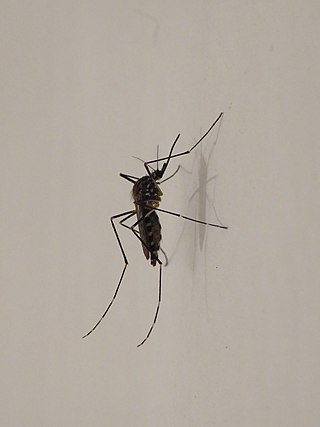
Toxorhynchites, also called elephant mosquito or mosquito eater, is a genus of diurnal and often relatively colorful mosquitoes, found worldwide between about 35° north and 35° south. Most species occur in forests. It includes the largest known species of mosquito, at up to 18 mm (0.71 in) in length and 24 mm (0.94 in) in wingspan. It is among the many kinds of mosquito that do not consume blood. The adults subsist on carbohydrate-rich materials, such as honeydew, or saps and juices from damaged plants, refuse, fruit, and nectar.
Pseudoficalbia is a subgenus of the mosquito genus Uranotaenia with 146 species. It was originally created as a genus by Frederick Vincent Theobald in 1911 ; however, it was later treated as a subgenus of Uranotaenia, and then was made a synonym of the same genus. It was later restored as a subgenus by E.L. Peyton in 1972.
Aedes apicoargenteus is an African mosquito species, first described as Stegomyia apicoargentea from specimens collected in Ashanti, Ghana.
Aedes vittatus is a species of mosquito that was first described in 1861 as Culex vittatus from specimens collected on Corsica. In 2000, the species was transferred to the newly erected subgenus Fredwardsius as the type species representing the subgenus.
Aedes furcifer was named in 1913 as a nomen novum for nigra (Theobald). Aedes furcifer and Aedes taylori have been treated as two species, usually found sympatrically, but are difficult to separate morphologically so the term "Aedes furcifer-taylori group" has been used for the two species, and they have not always been differentiated by workers conducting studies on them.
Aedes luteocephalus is an African species that is a demonstrated or suspected vector of several important arboviral diseases of humans. First described in 1907 as Stegomyia luteocephala, the species is currently classified in the genus Aedes, subgenus Stegomyia.
Aedes hoogstraali is a species of mosquito. It was first described from specimens collected at Subic Bay, Republic of the Philippines in 1945. The specific epithet honors noted entomologist and acarologist Harry Hoogstraal.

Coquillettidia is a mosquito genus erected by entomologist Harrison Gray Dyar Jr. in 1904 based primarily on unique features of its "peculiar" male genitalia. The specific epithet honors Dyar's colleague Daniel William Coquillett.
Haemogogus clarki is an arboreal mosquito native to southern Central America and northern South America. It is deep brown in color with conspicuous patterns of silver scales on the scutum and pleuron. The specific epithet honors Dr. Herbert C. Clark, former Director of the Gorgas Memorial Laboratory.
Haemagogus soperi is a species of mosquito found in the coastal plain region of Ecuador. The specific epithet honors Dr. Frederick Lowe Soper.
Aedes cordellieri is a sub-Saharan African species of mosquito suspected of being a vector of yellow fever. The species name honors Dr. Roger Cordellier, a former medical entomologist with Office de la Recherche Scientifique et Technique Outre-Mer (ORSTOM) in Ivory Coast, in recognition of his contributions to the knowledge of the mosquito fauna of Africa.
Culex perfuscus is the only Culex species mosquito currently implicated as a possible vector of Zika virus. The species type was described in 1914 from Port Herald, Nyasaland by entomologist Frederick Wallace Edwards.
Lutzia is a genus of mosquitos. First described in 1903 by Frederick Vincent Theobald, it includes species whose larval stages exhibit predatory behavior. The type species is Lutzia bigoti.
The subgenus Kerteszia are Neotropical anopheline mosquitoes originally described in 1905 by Frederick V. Theobald as genus Kertészia with Kertészia boliviensis as the type species.

Sabethes mosquitoes are primarily an arboreal genus, breeding in plant cavities. The type species is Sabethes locuples, first described by Jean-Baptiste Robineau-Desvoidy in 1827.
Sabethes lutzii is a species name designated a "nomen dubium" i.e., a "dubious name," for a mosquito specimen that remains insufficiently evidenced to be accepted as a proved species.

Aedes koreicus is a mosquito species originally described from Korea that has been shown to be enzootic to Japan, northeastern China, the Republic of Korea, parts of Russia, but recently found in Belgium, Italy, Germany, Hungary, Slovenia, Switzerland and Kazakhstan. Adult Aedes koreicus are relatively large, with areas of white scales on black background, strongly resembling Aedes japonicus, which has also become established outside its native range.
Lutzia shinonagai was first described in 1979. The genus name was originally spelled Lützia; the species name honors medical entomologist Dr. Satoshi Shinonaga who has published extensively on the taxonomy of the muscid, sarcophagid and calliphorid flies of Japan and the Oriental Region. Lutzia shinonagai is the only species in the subgenus Insulalutzia.
Lutzia fuscana is a mosquito that is predatory in its larval stages. It has been investigated as a possible biological control agent, showing some promise where vector species share limited or specific breeding habitat.
Anopheles nuneztovari is a species of mosquito in the order Diptera native to South America. The species was named by its discoverer, Arnoldo Gabaldón, to honor the Venezuelan entomologist Manuel Núñez Tovar.



